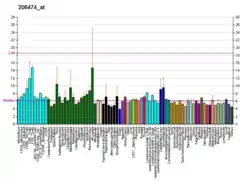PCTK2
Serine/threonine-protein kinase PCTAIRE-2 is an enzyme that in humans is encoded by the PCTK2 gene.[5][6]
The protein encoded by this gene belongs to the cdc2/cdkx subfamily of the ser/thr family of protein kinases. It has similarity to rat protein which is thought to play a role in terminally differentiated neurons.[6]
References
- GRCh38: Ensembl release 89: ENSG00000059758 - Ensembl, May 2017
- GRCm38: Ensembl release 89: ENSMUSG00000020015 - Ensembl, May 2017
- "Human PubMed Reference:". National Center for Biotechnology Information, U.S. National Library of Medicine.
- "Mouse PubMed Reference:". National Center for Biotechnology Information, U.S. National Library of Medicine.
- Hirose T, Tamaru T, Okumura N, Nagai K, Okada M (Dec 1997). "PCTAIRE 2, a Cdc2-related serine/threonine kinase, is predominantly expressed in terminally differentiated neurons". Eur J Biochem. 249 (2): 481–8. doi:10.1111/j.1432-1033.1997.t01-1-00481.x. PMID 9370357.
- "Entrez Gene: PCTK2 PCTAIRE protein kinase 2".
Further reading
- Meyerson M, Enders GH, Wu CL, et al. (1992). "A family of human cdc2-related protein kinases". EMBO J. 11 (8): 2909–17. doi:10.1002/j.1460-2075.1992.tb05360.x. PMC 556772. PMID 1639063.
- Hirose T, Kawabuchi M, Tamaru T, et al. (2000). "Identification of tudor repeat associator with PCTAIRE 2 (Trap). A novel protein that interacts with the N-terminal domain of PCTAIRE 2 in rat brain". Eur. J. Biochem. 267 (7): 2113–21. doi:10.1046/j.1432-1327.2000.01218.x. PMID 10727952.
- Yamochi T, Nishimoto I, Okuda T, Matsuoka M (2001). "ik3-1/Cables is associated with Trap and Pctaire2". Biochem. Biophys. Res. Commun. 286 (5): 1045–50. doi:10.1006/bbrc.2001.5493. PMID 11527406.
- Strausberg RL, Feingold EA, Grouse LH, et al. (2003). "Generation and initial analysis of more than 15,000 full-length human and mouse cDNA sequences". Proc. Natl. Acad. Sci. U.S.A. 99 (26): 16899–903. doi:10.1073/pnas.242603899. PMC 139241. PMID 12477932.
- Conte N, Delaval B, Ginestier C, et al. (2003). "TACC1-chTOG-Aurora A protein complex in breast cancer". Oncogene. 22 (50): 8102–16. doi:10.1038/sj.onc.1206972. PMID 14603251.
- Jin J, Smith FD, Stark C, et al. (2004). "Proteomic, functional, and domain-based analysis of in vivo 14-3-3 binding proteins involved in cytoskeletal regulation and cellular organization". Curr. Biol. 14 (16): 1436–50. doi:10.1016/j.cub.2004.07.051. PMID 15324660. S2CID 2371325.
- Gerhard DS, Wagner L, Feingold EA, et al. (2004). "The status, quality, and expansion of the NIH full-length cDNA project: the Mammalian Gene Collection (MGC)". Genome Res. 14 (10B): 2121–7. doi:10.1101/gr.2596504. PMC 528928. PMID 15489334.
- Barrios-Rodiles M, Brown KR, Ozdamar B, et al. (2005). "High-throughput mapping of a dynamic signaling network in mammalian cells". Science. 307 (5715): 1621–5. doi:10.1126/science.1105776. PMID 15761153. S2CID 39457788.
- Rual JF, Venkatesan K, Hao T, et al. (2005). "Towards a proteome-scale map of the human protein-protein interaction network". Nature. 437 (7062): 1173–8. doi:10.1038/nature04209. PMID 16189514. S2CID 4427026.
- Wissing J, Jänsch L, Nimtz M, et al. (2007). "Proteomics analysis of protein kinases by target class-selective prefractionation and tandem mass spectrometry". Mol. Cell. Proteomics. 6 (3): 537–47. doi:10.1074/mcp.T600062-MCP200. PMID 17192257.
This article is issued from Wikipedia. The text is licensed under Creative Commons - Attribution - Sharealike. Additional terms may apply for the media files.






